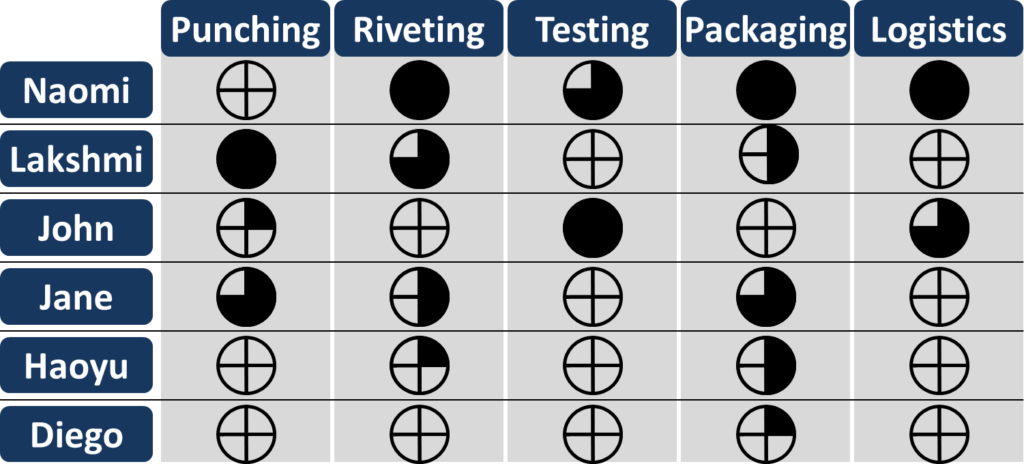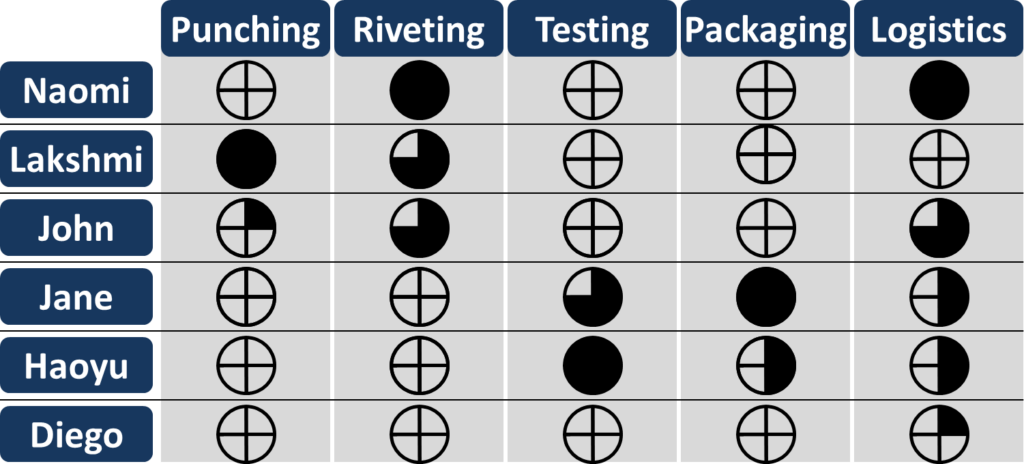 In my last post, I described how to build a qualification matrix (also skill matrix, competence matrix, or Q-Matrix). In this post I will go into more detail on how to use a qualification matrix. By itself, the qualification matrix is a pretty simple but useful tool. This post will help you to get the most out of it.
In my last post, I described how to build a qualification matrix (also skill matrix, competence matrix, or Q-Matrix). In this post I will go into more detail on how to use a qualification matrix. By itself, the qualification matrix is a pretty simple but useful tool. This post will help you to get the most out of it.
Quick Recap
As explained in my last post, the qualification matrix is a simple matrix with a list of people on one axis and a list of their qualifications on the other axis.
The qualification matrix has a few main uses:
Work Assignment
 The main use of a skill matrix is to see which worker is qualified for which job when assigning different tasks. Often, a qualification matrix is used in combination with a work assignment matrix. This is especially important on the shop floor, where the assignment of the workers to the different processes may change with each shift. In this case, the sequence of skills on the qualification matrix and the sequence of tasks on the work assignment matrix should be identical; otherwise it requires more attention and may have more frequent mistakes.
The main use of a skill matrix is to see which worker is qualified for which job when assigning different tasks. Often, a qualification matrix is used in combination with a work assignment matrix. This is especially important on the shop floor, where the assignment of the workers to the different processes may change with each shift. In this case, the sequence of skills on the qualification matrix and the sequence of tasks on the work assignment matrix should be identical; otherwise it requires more attention and may have more frequent mistakes.
Hence, when assigning tasks to the different workers, the skill matrix (or at least the knowledge of who can do what) is needed to ensure every required task is covered by someone able to do the task.
For project work in an office, the work assignment matrix is often expanded into a responsibility assignment matrix (RAM matrix) or RACI matrix, where for each task there is someone responsible (R) and accountable (A), but possibly also consulted (C) or informed (I). (There may also be many more similar approaches, like PARIS, PACSI, RACIQ, DACI, RATSI, RASCEIO, and many more, mainly to make consultants happy. See Wikipedia for a list.). In any case, here too the person assigned to any RACI should be able to do the part of the RACI.
Identify Qualification Needs
A second major use of the qualification matrix is to check for qualification needs. Where do you have gaps in your qualifications? Please note the goal here is not to have everybody qualified in everything. That may cost a fortune, and may not be possible at all.
But you should have enough people that all necessary tasks can be done, even if a person is sick and another one is on holiday. See the matrix below for an example of a couple of critical points. In punching, we have two people on the matrix, Lakshmi and John, but John is a beginner who just started training on the punching machine. If Lakshmi becomes sick, goes on holiday, or quits the job, then there will be a major problem. Hence, punching has a major need for additional qualification to ensure smooth operations even if someone is absent.
Another, less obvious problem is testing and packaging. Both have two people who are qualified to work on their own, hence the minimum requirement should be satisfied. However, it is the very same people, Jane and Haoyu, for both testing and packaging. If one works in testing, then the other works in packaging, or vice versa. If one of them is absent, then you can run only one of the two processes. This is also a major qualification need. (Obviously, if testing would only be an occasional side job that can be done by one person in addition to packaging, this would be less of an issue).
Also, keep an eye out for if one qualification is needed for multiple workstations. For example, if you have two riveting machines, then having only three people qualified for riveting is a bit tight. If one is on holiday (plannable) and another one is sick (unplanned), then you cannot run both machines. Overall, you should have at least two people for each job who are qualified enough to do the job on their own. Even two people may be tight in some cases, and three may be more comfortable. This qualification matrix helps you to see such qualification bottlenecks.
There may even be work assignment structures that must have multi-skilled workers, like the baton touch or the bucket brigade, or qualified for ALL processes like the rabbit chase. See below for two qualification matrix examples for the baton touch and the rabbit chase.


There may also be examples were it is necessary that every employee has a certain qualification. For example, in some companies it is required that every employee has an ethics or code of conduct training. (But this may be less for the employee to behave ethically and more for the manager to deflect accusations if the employee doesn’t.)
But overall, a qualification matrix is an useful tool to see where you have training needs, to prevent problems later on if one or more employees are absent.
Employee Evaluation
 Another use of a qualification matrix is for employee evaluations. This could be during the hiring process, or later during regular (annual?) performance reviews. But, to be honest, I am not so hot on this usage. I have seen examples where the qualification matrix is even used to determine an employee score (weighted qualifications multiplied with the qualification level) to estimate the overall value of an employee. But I (and probably many employees) would find this offensive. I am generally skeptical about numerical performance evaluations. Hence my recommendation is: Don’t use a qualification matrix to determine the value of an employee. Of course, a higher-skilled person is better for the company, but there is more than just the entries in the qualification matrix for this.
Another use of a qualification matrix is for employee evaluations. This could be during the hiring process, or later during regular (annual?) performance reviews. But, to be honest, I am not so hot on this usage. I have seen examples where the qualification matrix is even used to determine an employee score (weighted qualifications multiplied with the qualification level) to estimate the overall value of an employee. But I (and probably many employees) would find this offensive. I am generally skeptical about numerical performance evaluations. Hence my recommendation is: Don’t use a qualification matrix to determine the value of an employee. Of course, a higher-skilled person is better for the company, but there is more than just the entries in the qualification matrix for this.
However, the qualification matrix could be used for target setting. For example, during the evaluation, a possible goal for the employee could be to become qualified in certain skills to a certain level, to be reviewed during the next evaluation.
Overall, the qualification matrix is a simple and useful tool to keep track of the skills of your people, and to help you optimize and improve the skill set in your company to better match the needs. Now, go out, see where your team has gaps in their qualifications, and organize your industry!



Hello Mr. Roser,
i really enjoyed reading your posts about the Q-Matrix. It is much more visual with the harvey balls than working with numbered scales (actually no transparency, if you have many team members or processes). After i have read your post, i modified our Q-Matrixes and i can see a great benefit.
You raise the subject with the tracking of the skills of the employees. Do you also have an idea how to visualise the seeking levels? It would be great, if you can add it to the current status. Maybe via coloured or crosshatched areas?
Greetings
Thanh Ha Vu
Hi Thanh, glad the Harvey balls were useful. I find them good visualizations. Thanks for teh feedback!
I am not sure what you mean by “seeking levels”. Is this where the employee wants to be? In this case your idea of shading the Harvey balls is actually quite nice. Black is what they already have, and some shading in color could indicate the future path. As for the color, red is a bit agresive, green indicates OK status already, blue is too close to black, and yellow is hard to see. Maybe indeed red? Assuming you don’t have a “light turquoise” or orange edding lying around 😉
In my experience to determine the value of an employee is absolutely nececessary evaluate also the ‘soft skills’.